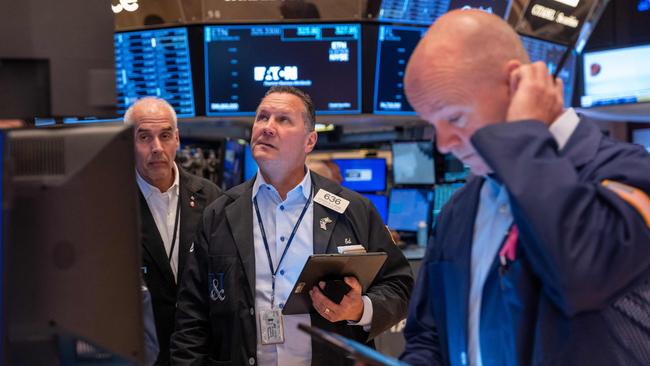Goldman Sachs sees rising risk of a drawdown amid political uncertainty
After another surprisingly resilient quarter for Western economies and markets, political uncertainty is increasingly seen as a hurdle.

It was another surprisingly resilient quarter for Western economies and markets, but political uncertainty is increasingly seen as a hurdle by economists and traders.
Barclays warns that election uncertainty has started to weigh on the outlook for Europe and the US, amid polls in France and the UK and heightened focus on the US presidential race.
And Goldman Sachs has told clients to buy some “inexpensive downside protection” as the probability of a drawdown is “rising” as the global election cycle plays out.
As has been the case since 2022, US tech giants continue to drive the global stockmarket, and while sticky inflation delayed rate cuts in the US and Australia, several G10 countries began to cut.
But there’s little doubt that the stockmarket would not have fared so well if US and European economic growth hadn’t proved surprisingly resilient to rate hikes or bond yields had really spiked.
However, after surprising positively for most of this year, Citi’s “economic surprise” indicators show the US began surprising negatively in early May. The EU began surprising negatively in late June.
J.P. Morgan’s global manufacturing PMI index has been in “expansion” since February and its global services PMI index has been in expansion since February 2023. However, Barclays says Europe is now showing “signs of softness” after significant falls in euro area flash June PMI’s and economic sentiment, as well as the important German IFO business survey.
“The recovery path for Europe’s economy may be most at risk from the uncertainty the French election implies for France as well as Europe,” said the UK bank’s head of economics research, Christian Keller.
Final manufacturing PMIs and services and composite PMIs in Europe this week will be watched for any further effects of uncertainty after the announcement of election results in France.
The French/German 10-year bond spread briefly hit a 12-year high of 84 basis points last week.
After the first round of French parliamentary elections over the weekend, far-right National Rally party made big gains to win about 34.5 per cent of the vote.
The UK heads to the polls on Thursday. Labour is on track to win a comfortable majority.
In the US, a poor showing by Joe Biden in the first presidential debate fuelled uncertainty about whether he might step aside before the November election even as he vowed to continue.
However, US economic resilience “remains broadly intact”, according to Keller.
US economic data this week, including non-farm payrolls and ISM manufacturing and services sector PMIs, are expected to “continue to downplay risks of a significant deterioration” in activity.
Meanwhile, China’s domestic financial market valuations suggest that expectations heading into the Communist Party’s third plenum meeting from July 15-18 are low.
There’s now a consensus that China has exhausted options on its property front and there’s little room for the sector to surprise on the upside. A broad focus on supply-side reforms to promote tech innovation and supply chain self-reliance will be seen as “more of the same”.
What would move the needle for risk is a focus on demand-side stimulus, but that is a low-probability event, according to Keller.
US inflation dynamics continue to allow for a September rate cut, and European disinflation remains on track, while the European Central Bank’s forum on central banking in Sintra this week could provide clarity on the potential response of the ECB to any bond market turmoil related to the French elections.
But after “exceedingly good run for US equities”, it’s a “good time to tap the brakes”, according to Goldman Sachs managing director of global banking and markets Tony Pasquariello.
Since April, a basket of US mega cap tech stocks – “the weapon of choice” – has ripped 24 per cent, giving the Nasdaq 100 its best month of the year and a first-half total return of 18 per cent.
“Despite all of this well-earned strength and momentum, my instinct is that now would be a good time to tap the brakes,” Pasquariello told clients.
The S&P 500 and Nasdaq 100 both formed “bearish key day reversal” patterns on Friday after hitting record highs amid month/quarter end flows. S&P 500 futures were up 0.3 per cent early on Monday.
Pasquariello saw “a few gathering risks to the bullish narrative” for US stocks.
“The biggest is our eye-popping, ever-worsening fiscal binge: this year’s deficit is now expected to be $US1.9 trillion ($2.8 trillion), which marks a widening of $US400bn from just four months ago,” he said.
“As the US election cycle takes shape, I worry about the vulnerability of long-dated treasuries.”
Another risk is the continued build-up of exposure in the trading community, with regard to the positioning of both households and professionals.
And while March-quarter gains in the S&P 500 were relatively broad, the rip since April has been principally driven by a small set of stocks.
“That’s certainly not something that I wanted to fight, but the history book tells us the risk of a sell-off increases as the rally narrows,” Pasquariello said.
It’s not a “run-for-the-hills argument” as the US market retains some “deep fundamental supports”, including remarkably friendly financial conditions, an improving growth-inflation trade-off and the “structural supremacy of US mega cap tech” stocks.
He concedes it’s “hard to calibrate downshifts” after a “spectacular period for risky assets”.
But he says the probability of a drawdown is rising and clients should look to “reduce overall portfolio risk as we navigate the next phase of the political game”.
“I think volatility will drift higher as the global election cycle plays out,” he said.






To join the conversation, please log in. Don't have an account? Register
Join the conversation, you are commenting as Logout